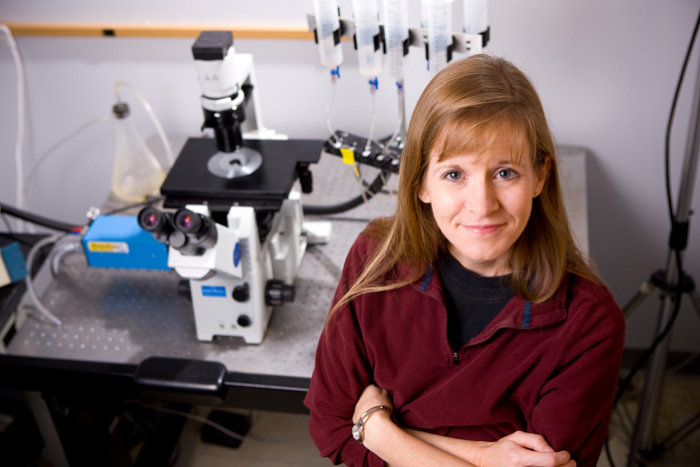 Kathryn Medler
Kathryn Medler Kathryn Medler
Kathryn MedlerPhysiology of Neuronal Cell Signaling Pathways
Associate Professor
PhD (1994-1998) Louisiana State University
Post-doctoral researcher (1998-1999) Louisiana State University
Post-doctoral researcher (1999-2003) Colorado State University
Assistant Professor, Special Track (2003-2004) Colorado State
University
Assistant Professor (2004) University at Buffalo,
Associate Professor (2011-present) University at Buffalo
My lab studies the physiology of signal transduction pathways and the regulation of these pathways in neuronal systems. We focus on peripheral sensory systems, primarily the taste system. Chemical sensory systems, which are comprised of olfaction and taste, play important roles in feeding, territorial recognition and social interactions. The taste sensory system is used to determine whether potential food items will be ingested or rejected while the olfactory system is used in a multitude of behaviors such as kin recognition and mate selection. The taste system is extremely heterogeneous and is made up of multiple cell types that depend on multiple signaling pathways to detect stimuli. Some stimuli interact with receptors that initiate second messenger cascades, while others interact directly with ion channels to cause a cellular response. As characterization of these cellular mechanisms continues, we can begin understanding how the brain gathers information about its surroundings. The long term goal of the lab is to begin understanding how signaling mechanisms are regulated within taste cells and how this regulation impacts the generation of the stimulus signal to the brain. We use molecular and physiological techniques, including patch clamp analysis and calcium imaging to investigate how signaling mechanisms in taste cells function.
 |
My lab studies the physiology of signal transduction pathways and the regulation of these pathways in neuronal systems. We focus on peripheral sensory systems, primarily the taste system. The taste system is used to determine whether potential food items will be ingested or rejected and has important, though poorly characterized, roles in appetite and food intake. When the relationship between taste and appetite is damaged, eating problems such as malnutrition and obesity can occur. The lab is currently interested in deciphering the relationship between obesity and taste. We have found that diet induced obesity has significant effects on the properties of taste cells found in the tongue and current studies are focused on understanding how this happens.
• Defining the relationship between diet-induced obesity and taste cell signaling
The taste system is extremely heterogeneous and is made up of multiple cell types that depend on multiple signaling pathways to detect stimuli. Some stimuli interact with receptors that initiate second messenger cascades, while others interact directly with ion channels to cause a cellular response. We recently identified a new signaling pathway in taste cells that contributes to the detection of certain taste stimuli. As characterization of these cellular mechanisms continues, we can begin understanding how the brain gathers information about its surroundings. Another long term goal of the lab is to begin understanding how each signaling mechanism contributes to the detection and perception of taste stimuli. Current studies using calcium and sodium imaging along with molecular techniques are focused on defining the role of each of these pathways.
• Characterization of the PLCb3 signaling pathway in taste cells
• Defining the role of TRPM4 in taste cells
Signal regulation within cells is a critical part of generating an appropriate response to a stimulus. However, little is known about how signals are regulated within taste cells and how this regulation impacts the stimulus signal sent to the brain. We use molecular and physiological techniques, including patch clamp analysis and live cell imaging to investigate how signaling mechanisms in taste cells function.
• Characterization of calcium buffering mechanisms in taste cells
Taste cells are unique in that they have characteristics of both neurons and epithelial cells. Like neurons, they are excitable cells, form synapses and fire action potentials but like epithelial cells, they are routinely replaced throughout an organism’s life. Cell turnover and maintenance is not well understood and many factors likely contribute to this process. We have found that a transcription factor, WT1, which is important in cell growth and differentiation and plays a role in pediatric kidney cancer, is expressed in taste cells. Our initial studies have found that WT1 is required for the normal development of the peripheral taste system and it is also controlling the expression of several genes in adult cells that may have important roles in cell maintenance. Current studies in the lab are focused on elucidating the role of WT1 in the maintenance of the peripheral taste system.
• Transcriptional regulation of taste development and maintenance